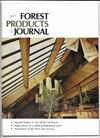斯里兰卡Moratuwa木工产业集群中的木材残留物:行业协同效应和增值产品的潜力
IF 1.2
4区 农林科学
Q3 FORESTRY
引用次数: 3
摘要
莫拉图瓦木工产业集群(MWIC)是斯里兰卡一个地理上集中的集群,拥有1600多家中小型木材制造和零售设施。这些公司包括家具制造商、木工店、锯木厂和综合锯木厂。工业共生的概念探讨了工业设施之间的协同作用,以交换能源,水,副产品和废物,以实现更高的资源利用效率。进行这项研究的目的是为了解决缺乏关于MWIC内产生的木材残留物的定量资料的问题。对180家初级和次级木材产品制造商进行了调查,以量化MWIC公司副产品的生产和木材残留物的消费,为可能的最终用途和废物协同作用建立基线。木材废弃物产生企业总数为730家;零售设施不包括在内。锯木厂生产了MWIC每月6490吨木材残渣的约66%,其余由木工和综合企业生产。柚木(Tectona grandis)和红木(swetenia macrophylla)是MWIC中使用的优势树种,占木材废料的大部分。调查确定了三种主要类型的木材废料:锯末(76.5%),明显衰落的木板(16.5%),不能用于进一步产品,以及边材(6.9%)。目前,MWIC产生的木材废料中只有55%得到利用;剩下的45%被送往垃圾填埋场或以其他方式处理,例如丢弃在水道或其他未经批准的地点。决定在工厂一级改进按类型分类的木材废料和在MWIC内汇总的木材废料,以增加木材废料作为MWIC其他木材制造部门潜在投入的可用性。本文章由计算机程序翻译,如有差异,请以英文原文为准。
Wood Residues in the Moratuwa Woodworking Industry Cluster of Sri Lanka: Potential for Sector Synergies and Value-Added Products
The Moratuwa Woodworking Industry Cluster (MWIC) is a geographically concentrated cluster of over 1,600 small-to-medium scale wood-based manufacturing and retail facilities in Sri Lanka. Firms include furniture manufacturers, carpentry shops, sawmills, and integrated sawmills. The concept of industrial symbiosis explores the synergies between industrial facilities to exchange energy, water, by-products, and waste to achieve a higher efficiency in resource utilization. This research was undertaken to address the lack of quantitative information on wood residues generated within the MWIC. A survey of 180 primary and secondary wood product manufacturers was undertaken to quantify MWIC firm by-product production and consumption of wood residues to establish a baseline for possible end use and waste synergies. The total population of enterprises generating wood waste is 730; retail facilities are not included. Sawmills produce approximately 66% of the 6,490 MT of MWIC's monthly wood residue generation, with the balance produced by carpentry and integrated enterprises. Teak (Tectona grandis) and mahogany (Swietenia macrophylla) are the dominant species used in the MWIC, accounting for most of the wood waste. Three main types of wood waste were identified in the survey: sawdust (76.5%), boards with significant wane (16.5%) unusable for further products, and offcuts (6.9%). Only 55% of the wood waste generated in MWIC is currently used; the remaining 45% is taken to landfills or disposed of in other ways, such as discarded in waterways or other nonapproved locations. Improved wood waste sorting by type at the mill level and aggregated wood waste within the MWIC was determined to increase the usability of wood waste as potential inputs in other wood manufacturing sectors in the MWIC.
求助全文
通过发布文献求助,成功后即可免费获取论文全文。
去求助
来源期刊

Forest Products Journal
工程技术-材料科学:纸与木材
CiteScore
2.10
自引率
11.10%
发文量
30
审稿时长
6-12 weeks
期刊介绍:
Forest Products Journal (FPJ) is the source of information for industry leaders, researchers, teachers, students, and everyone interested in today''s forest products industry.
The Forest Products Journal is well respected for publishing high-quality peer-reviewed technical research findings at the applied or practical level that reflect the current state of wood science and technology. Articles suitable as Technical Notes are brief notes (generally 1,200 words or less) that describe new or improved equipment or techniques; report on findings produced as by-products of major studies; or outline progress to date on long-term projects.
 求助内容:
求助内容: 应助结果提醒方式:
应助结果提醒方式:


